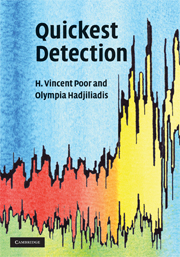
-
Select format
-
- Publisher:
- Cambridge University Press
- Publication date:
- 06 July 2010
- 20 November 2008
- ISBN:
- 9780511754678
- 9780521621045
- Dimensions:
- (247 x 174 mm)
- Weight & Pages:
- 0.64kg, 244 Pages
- Dimensions:
- Weight & Pages:
You may already have access via personal or institutional login
Book description
The problem of detecting abrupt changes in the behavior of an observed signal or time series arises in a variety of fields, including climate modeling, finance, image analysis, and security. Quickest detection refers to real-time detection of such changes as quickly as possible after they occur. Using the framework of optimal stopping theory, this book describes the fundamentals underpinning the field, providing the background necessary to design, analyze, and understand quickest detection algorithms. For the first time the authors bring together results which were previously scattered across disparate disciplines, and provide a unified treatment of several different approaches to the quickest detection problem. This book is essential reading for anyone who wants to understand the basic statistical procedures for change detection from a fundamental viewpoint, and for those interested in theoretical questions of change detection. It is ideal for graduate students and researchers of engineering, statistics, economics, and finance.
Reviews
'Nothing endures but change. This timely book applies Heraclitus' fundamental principle to the processes used to describe change itself. As financial markets ebb and flow, practitioners schooled in quickest detection stand the greatest chance for survival.'
Peter Carr - Head of Quantitative Financial Research, Bloomberg
'Quickest Detection is a fascinating read and a nice summary of the state of the art in this area. I would recommend it for use in either coursework or practical engineering.'
Source: IEEE Microwave Magazine
Contents
Metrics
Altmetric attention score
Full text views
Full text views help Loading metrics...
Loading metrics...
* Views captured on Cambridge Core between #date#. This data will be updated every 24 hours.
Usage data cannot currently be displayed.
Accessibility standard: Unknown
Why this information is here
This section outlines the accessibility features of this content - including support for screen readers, full keyboard navigation and high-contrast display options. This may not be relevant for you.
Accessibility Information
Accessibility compliance for the PDF of this book is currently unknown and may be updated in the future.


